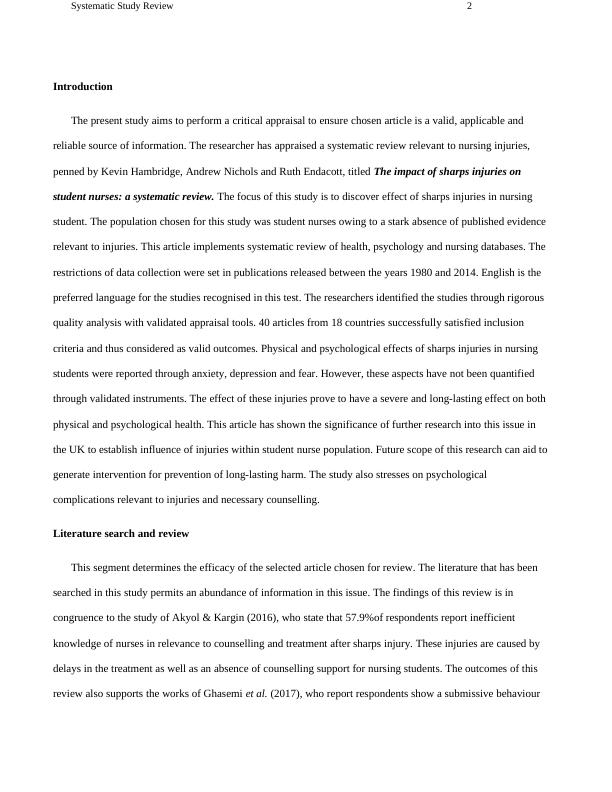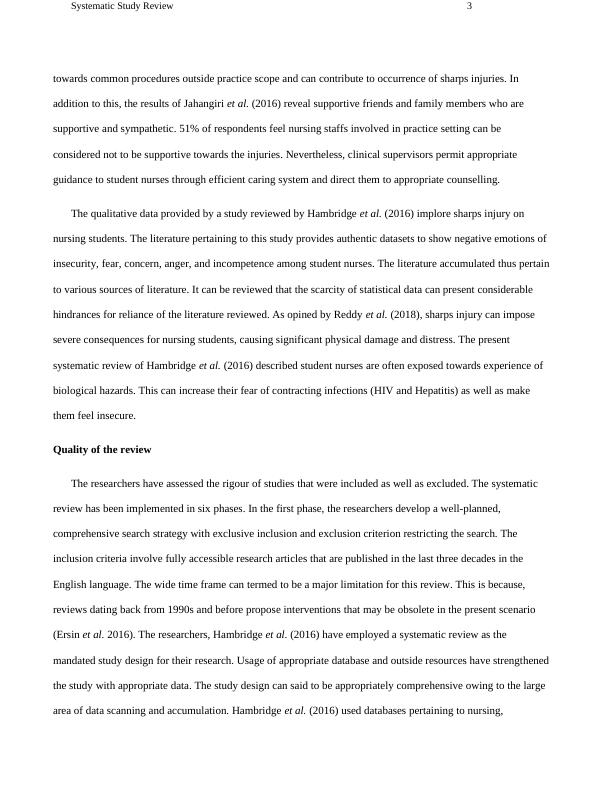Systematic Study Review.
Added on 2023-04-12
12 Pages3031 Words144 Views
RUNNING HEAD: Systematic Study Review
SYSTEMATIC STUDY REVIEW
SYSTEMATIC STUDY REVIEW


Systematic Study Review 2
Introduction
The present study aims to perform a critical appraisal to ensure chosen article is a valid, applicable and
reliable source of information. The researcher has appraised a systematic review relevant to nursing injuries,
penned by Kevin Hambridge, Andrew Nichols and Ruth Endacott, titled The impact of sharps injuries on
student nurses: a systematic review. The focus of this study is to discover effect of sharps injuries in nursing
student. The population chosen for this study was student nurses owing to a stark absence of published evidence
relevant to injuries. This article implements systematic review of health, psychology and nursing databases. The
restrictions of data collection were set in publications released between the years 1980 and 2014. English is the
preferred language for the studies recognised in this test. The researchers identified the studies through rigorous
quality analysis with validated appraisal tools. 40 articles from 18 countries successfully satisfied inclusion
criteria and thus considered as valid outcomes. Physical and psychological effects of sharps injuries in nursing
students were reported through anxiety, depression and fear. However, these aspects have not been quantified
through validated instruments. The effect of these injuries prove to have a severe and long-lasting effect on both
physical and psychological health. This article has shown the significance of further research into this issue in
the UK to establish influence of injuries within student nurse population. Future scope of this research can aid to
generate intervention for prevention of long-lasting harm. The study also stresses on psychological
complications relevant to injuries and necessary counselling.
Literature search and review
This segment determines the efficacy of the selected article chosen for review. The literature that has been
searched in this study permits an abundance of information in this issue. The findings of this review is in
congruence to the study of Akyol & Kargin (2016), who state that 57.9%of respondents report inefficient
knowledge of nurses in relevance to counselling and treatment after sharps injury. These injuries are caused by
delays in the treatment as well as an absence of counselling support for nursing students. The outcomes of this
review also supports the works of Ghasemi et al. (2017), who report respondents show a submissive behaviour
Introduction
The present study aims to perform a critical appraisal to ensure chosen article is a valid, applicable and
reliable source of information. The researcher has appraised a systematic review relevant to nursing injuries,
penned by Kevin Hambridge, Andrew Nichols and Ruth Endacott, titled The impact of sharps injuries on
student nurses: a systematic review. The focus of this study is to discover effect of sharps injuries in nursing
student. The population chosen for this study was student nurses owing to a stark absence of published evidence
relevant to injuries. This article implements systematic review of health, psychology and nursing databases. The
restrictions of data collection were set in publications released between the years 1980 and 2014. English is the
preferred language for the studies recognised in this test. The researchers identified the studies through rigorous
quality analysis with validated appraisal tools. 40 articles from 18 countries successfully satisfied inclusion
criteria and thus considered as valid outcomes. Physical and psychological effects of sharps injuries in nursing
students were reported through anxiety, depression and fear. However, these aspects have not been quantified
through validated instruments. The effect of these injuries prove to have a severe and long-lasting effect on both
physical and psychological health. This article has shown the significance of further research into this issue in
the UK to establish influence of injuries within student nurse population. Future scope of this research can aid to
generate intervention for prevention of long-lasting harm. The study also stresses on psychological
complications relevant to injuries and necessary counselling.
Literature search and review
This segment determines the efficacy of the selected article chosen for review. The literature that has been
searched in this study permits an abundance of information in this issue. The findings of this review is in
congruence to the study of Akyol & Kargin (2016), who state that 57.9%of respondents report inefficient
knowledge of nurses in relevance to counselling and treatment after sharps injury. These injuries are caused by
delays in the treatment as well as an absence of counselling support for nursing students. The outcomes of this
review also supports the works of Ghasemi et al. (2017), who report respondents show a submissive behaviour

Systematic Study Review 3
towards common procedures outside practice scope and can contribute to occurrence of sharps injuries. In
addition to this, the results of Jahangiri et al. (2016) reveal supportive friends and family members who are
supportive and sympathetic. 51% of respondents feel nursing staffs involved in practice setting can be
considered not to be supportive towards the injuries. Nevertheless, clinical supervisors permit appropriate
guidance to student nurses through efficient caring system and direct them to appropriate counselling.
The qualitative data provided by a study reviewed by Hambridge et al. (2016) implore sharps injury on
nursing students. The literature pertaining to this study provides authentic datasets to show negative emotions of
insecurity, fear, concern, anger, and incompetence among student nurses. The literature accumulated thus pertain
to various sources of literature. It can be reviewed that the scarcity of statistical data can present considerable
hindrances for reliance of the literature reviewed. As opined by Reddy et al. (2018), sharps injury can impose
severe consequences for nursing students, causing significant physical damage and distress. The present
systematic review of Hambridge et al. (2016) described student nurses are often exposed towards experience of
biological hazards. This can increase their fear of contracting infections (HIV and Hepatitis) as well as make
them feel insecure.
Quality of the review
The researchers have assessed the rigour of studies that were included as well as excluded. The systematic
review has been implemented in six phases. In the first phase, the researchers develop a well-planned,
comprehensive search strategy with exclusive inclusion and exclusion criterion restricting the search. The
inclusion criteria involve fully accessible research articles that are published in the last three decades in the
English language. The wide time frame can termed to be a major limitation for this review. This is because,
reviews dating back from 1990s and before propose interventions that may be obsolete in the present scenario
(Ersin et al. 2016). The researchers, Hambridge et al. (2016) have employed a systematic review as the
mandated study design for their research. Usage of appropriate database and outside resources have strengthened
the study with appropriate data. The study design can said to be appropriately comprehensive owing to the large
area of data scanning and accumulation. Hambridge et al. (2016) used databases pertaining to nursing,
towards common procedures outside practice scope and can contribute to occurrence of sharps injuries. In
addition to this, the results of Jahangiri et al. (2016) reveal supportive friends and family members who are
supportive and sympathetic. 51% of respondents feel nursing staffs involved in practice setting can be
considered not to be supportive towards the injuries. Nevertheless, clinical supervisors permit appropriate
guidance to student nurses through efficient caring system and direct them to appropriate counselling.
The qualitative data provided by a study reviewed by Hambridge et al. (2016) implore sharps injury on
nursing students. The literature pertaining to this study provides authentic datasets to show negative emotions of
insecurity, fear, concern, anger, and incompetence among student nurses. The literature accumulated thus pertain
to various sources of literature. It can be reviewed that the scarcity of statistical data can present considerable
hindrances for reliance of the literature reviewed. As opined by Reddy et al. (2018), sharps injury can impose
severe consequences for nursing students, causing significant physical damage and distress. The present
systematic review of Hambridge et al. (2016) described student nurses are often exposed towards experience of
biological hazards. This can increase their fear of contracting infections (HIV and Hepatitis) as well as make
them feel insecure.
Quality of the review
The researchers have assessed the rigour of studies that were included as well as excluded. The systematic
review has been implemented in six phases. In the first phase, the researchers develop a well-planned,
comprehensive search strategy with exclusive inclusion and exclusion criterion restricting the search. The
inclusion criteria involve fully accessible research articles that are published in the last three decades in the
English language. The wide time frame can termed to be a major limitation for this review. This is because,
reviews dating back from 1990s and before propose interventions that may be obsolete in the present scenario
(Ersin et al. 2016). The researchers, Hambridge et al. (2016) have employed a systematic review as the
mandated study design for their research. Usage of appropriate database and outside resources have strengthened
the study with appropriate data. The study design can said to be appropriately comprehensive owing to the large
area of data scanning and accumulation. Hambridge et al. (2016) used databases pertaining to nursing,

End of preview
Want to access all the pages? Upload your documents or become a member.
Related Documents
Systematic Review Analysislg...
|13
|3185
|493
Effectiveness of Psychological Support Strategies for Cancer Patientslg...
|48
|11028
|26
How Effective is Cognitive Behavioral Therapylg...
|23
|5098
|24
Conducting a Systematic Review: Methodology and Search Strategylg...
|4
|863
|336
Nursing Article 2022lg...
|10
|2338
|42
Case Study about Healthcare 2022lg...
|12
|3217
|19
